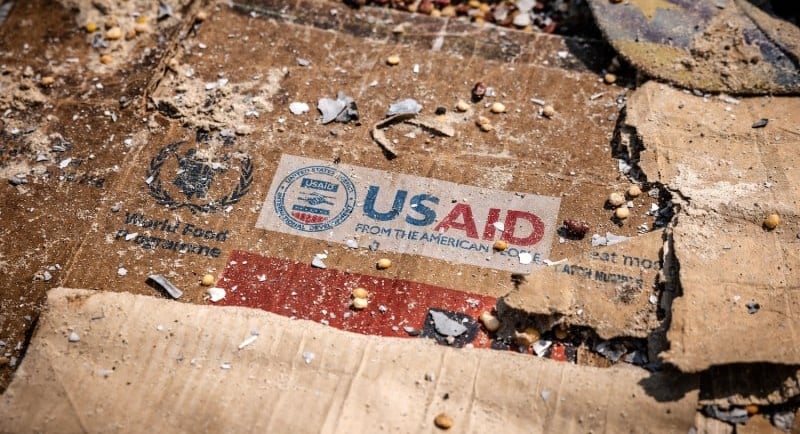United States: The End of USAID
On March 10, the U.S. government announced the end of almost all USAID programs, cutting thousands of contracts and redirecting billions of dollars. While the stated goal is to realign national priorities, investors and companies with global interests are left wondering: What does this sudden shift mean for the future of international markets and the opportunities that may arise in the aftermath?
UNITED STATES
Ekaterina Romanenko
3/15/20257 min read


On March 10, the United States officially terminated 83% of all USAID programs. The announcement by Secretary of State Marco Rubio confirmed that 5,200 contracts were cancelled following a six-week internal review. According to Rubio, these contracts accounted for tens of billions of dollars spent in ways that "did not serve — and in some cases harmed — the core national interests of the United States." Only around 1,000 programs remain operational, now transferred under direct State Department supervision.
The scale of this decision is unprecedented. In 2023 alone, USAID’s expenditures amounted to $63 billion. With the shutdown completed, thousands of projects across over 100 countries have ceased. These included infrastructure modernization, education initiatives, media funding, gender equality projects, humanitarian aid, environmental programs, and large-scale health interventions.
According to the White House, the decision was motivated not only by political reorientation but by mounting evidence of misuse and inefficiency. A report released in February cited instances of USAID funding, including $1.5 million for "promoting equality and inclusiveness in the workplace and business community in Serbia," $47,000 for a "transgender opera" in Colombia, $2 million for gender reassignment and "LGBT activism" in Guatemala, as well as "hundreds of thousands of dollars" for a nonprofit organization linked to "designated terrorist organizations."
Domestically, the agency’s contraction led to layoffs of approximately 1,600 employees. Internationally, staff reductions are stark: on the Ukrainian front, for instance, the number of USAID contractors and personnel shrank from 64 to 8. This is especially significant given the role USAID played as the largest donor to Ukrainian media, where 90% of outlets depend on foreign funding, as highlighted by Reporters Without Borders.
The influence of USAID extended far beyond Ukraine. The organization has historically funded major international and domestic media platforms, including Associated Press, The New York Times, and Politico. According to publicly available grant data, these outlets received millions of dollars over the past decade for coverage of democracy promotion and international development initiatives. The end of this funding may trigger both editorial shifts and structural cuts in international reporting desks. Some media analysts warn that publications that relied on USAID’s financial support will have to adjust their content strategies, potentially reducing coverage of regions where USAID operated.
In countries dependent on USAID support, the vacuum is already visible. Programs related to democratic institution-building, civil society development, election monitoring, and independent journalism funding have all stopped.
Certain countries may benefit from the absence of USAID. Some governments, particularly in parts of Eastern Europe and Latin America, have long perceived American aid as a mechanism of external pressure and conditionality. For instance, USAID has been accused of playing a role in fostering regime change and destabilization efforts. The agency's involvement in “democracy promotion” initiatives has been criticized for supporting actions that contributed to political upheavals and internal conflicts in countries like Ukraine, Georgia, Moldova, Armenia, and others.
In Venezuela, the government has accused USAID of financing efforts to overthrow its leadership. Venezuelan authorities claim that American funds were used to support opposition movements and destabilize the country’s government. The country’s executive vice president stated that USAID has been involved in financing actions against Venezuela, despite the "criminal blockade" imposed by the U.S.
Cuba, too, has accused USAID of using its programs as a cover for undermining the country's constitutional order. From 1998 to 1999, USAID allegedly spent over $6 million on illegal operations aimed at destabilizing Cuba. Between 2001 and 2006, the agency reportedly allocated $61 million to 142 illegal projects designed to undermine the Cuban government and its people. So the end of USAID involvement is likely to be welcomed by those authorities as an opportunity to consolidate control without external pressure or scrutiny.
In contrast, pro-Western governments and civil society organizations face immediate difficulties. The sudden shutdown of USAID programs has left critical gaps in humanitarian aid, food security, and health initiatives across multiple regions. According to an AP investigation, the suspension of these programs has already resulted in significant setbacks.
According to The Press Democrat, the impact is already severe. In Bangladesh, funding cuts have halted projects designed to improve food security and nutrition for 300,000 farming households. Burkina Faso has seen the cancellation of a literacy and health education program that supported over 17,000 learners. In Colombia, assistance to 12,500 farmers who had been transitioning from coca cultivation was abruptly discontinued. The Democratic Republic of Congo lost educational services for 275,000 children, while in Haiti more than 100,000 people have been left without access to essential health services, maternal care, and HIV treatment.
Organizations such as the World Food Programme and Save the Children have publicly expressed concern that these cuts are not just temporary disruptions but will lead to long-term setbacks in fighting hunger and disease. The loss of funding undermines years of institutional progress in improving child nutrition, reducing mortality, and strengthening local health systems.
For many pro-Western governments and NGOs, USAID was not only a financial pillar but also a key partner in implementing large-scale social projects. Its withdrawal forces them to urgently search for alternative funding, often without success.
The broader geopolitical impact is already becoming evident. Analysts widely agree that China stands to benefit most from the closure. In the absence of USAID — and without comparable Western structures to fill the gap — Chinese initiatives such as the Belt and Road Initiative and the Global Development Initiative are positioned to expand. Unlike USAID programs, which often came with political conditions and strict reporting requirements, Chinese development assistance is typically offered with fewer strings attached. This makes it particularly attractive to governments that seek investment without external oversight or political pressure. As a result, Beijing is likely to strengthen its influence in Africa, Southeast Asia, and Latin America.
Russia, too, may capitalize on the vacuum. Moscow has been increasing its influence in Africa and Latin America through trade deals, military cooperation, and diplomatic outreach. The removal of a major American competitor in these regions simplifies this task.
The shutdown’s economic consequences span both international markets and domestic U.S. realities. On the global stage, sectors tied to American foreign aid — including pharmaceuticals, construction, consulting, and education services — face contract losses. According to Focus Economics, U.S.-based pharmaceutical companies previously delivered vaccines and essential medicines under USAID programs worth billions. Construction firms specializing in infrastructure projects in Africa and Asia are reporting mass layoffs. Consultancy giants that relied on development program contracts are already facing revenue declines.
Logistics providers will also be affected. Humanitarian aid delivery accounted for a significant share of business for air cargo operators and maritime shipping companies contracted by USAID. The loss of these contracts may push some carriers to consolidate or exit certain routes altogether.
Inside the United States, the ripple effects are tangible. Several states — including Virginia, California, and Washington D.C. — have economies partially reliant on government development contracts. The layoffs within USAID, combined with reduced demand for contractors and consultants, are expected to result in thousands of job losses.
According to The Washington Post, unemployment claims in the District of Columbia spiked for the week ending February 22. Claims increased to 2,047, a 25 percent rise from the previous week and a fourfold increase compared to the same week last year. Overall, more than twice as many people in D.C. have filed for unemployment insurance this year compared to the same period last year. While this surge is not solely a result of the USAID program shutdown, it is nonetheless one of the contributing factors, along with the actions of the Trump administration as a whole. This trend highlights the broader consequences of these shifts.
Additionally, universities that received USAID grants for global research and student exchange programs will face budget cuts. Certain think tanks, reliant on USAID funding for regional studies, are downsizing their international research teams.
One notable example is the suspension of funding for agricultural research at U.S. universities. According to Reuters, a network of 17 laboratories funded by USAID under the Feed the Future Innovation Labs program has been particularly affected. These laboratories, which conducted research in partnership with countries such as Malawi, Tanzania, Bangladesh, and Rwanda, were integral in addressing global food security challenges. Directors of the labs stated that their research not only benefited developing countries but also supported American farmers by promoting agricultural practices that could be applied domestically or providing early warnings about pests and diseases. The cessation of this funding could significantly hinder progress in agricultural innovation that directly impacts both the U.S. and partner nations.
Investors are already beginning to reassess risks. According to Reuters, the sudden halt of billions of dollars in development financing has created uncertainty in emerging markets, particularly in countries like Sri Lanka, South Africa, and Ethiopia, where American-backed infrastructure and health projects had contributed to economic stability. Credit rating agencies are closely monitoring these changes, warning that the loss of predictable grant flows may undermine sovereign fiscal planning and complicate relationships with international lenders such as the IMF.
However, not all outcomes are negative. The shutdown offers opportunities for other countries and private-sector actors to step into roles vacated by USAID. European development agencies may expand their influence in Eastern Europe and Africa. Some private companies see opportunities for direct contracts with local governments no longer bound by USAID’s oversight mechanisms.
For American taxpayers, the official line is cost savings and a refocus on national interests. Rubio’s statements repeatedly emphasize a desire to reorient foreign assistance toward security and trade priorities aligned with U.S. goals.
Nevertheless, the transition comes with its own expenses. Legal challenges have emerged, with a U.S. federal judge ruling on March 18 that the administration overstepped constitutional limits by shutting down certain programs without Congressional approval. Appeals are underway, and protracted court battles may add costs and uncertainty.
In the coming months, attention will turn to how the remaining 1,000 programs, now under the State Department, are managed. There are concerns regarding efficiency and oversight. State Department structures are not designed to manage thousands of micro-level development initiatives. The possibility of bureaucratic overload and inefficiency remains high.
In summary, the closure of 83% of USAID programs is not a single event but the beginning of a major global and domestic reconfiguration. While the decision may align with current U.S. political priorities, its consequences — beneficial for some actors and detrimental for others — will continue to unfold in the months and years ahead.


